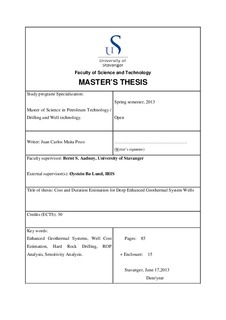| dc.contributor.author | Maita Pozo, Juan Carlos | |
| dc.date.accessioned | 2013-11-12T15:08:09Z | |
| dc.date.available | 2013-11-12T15:08:09Z | |
| dc.date.issued | 2013 | |
| dc.identifier.uri | http://hdl.handle.net/11250/183526 | |
| dc.description | Master's thesis in Petroleum engineering | no_NO |
| dc.description.abstract | Geothermal energy is today recognized as a weather independent and stable energy source with significant potential. The high cost of drilling long-reach wells is a key bottleneck and a show stopper for the realization of widespread exploitation of deep geothermal energy. Estimates for deep geothermal projects show that the drilling and well construction cost can be as high as 80% of total investment costs. Therefore understanding the intimacy of the costs involved in geothermal well construction will give an insight on how to reduce drilling costs and make EGS (Enhanced Geothermal System) a profitable investment for the upcoming years. For this reason, construction cost and duration simulation for a deep EGS well was performed using Risk€, a simulator developed by IRIS that uses Monte Carlo method for calculating oil & gas well budgets. Even though the simulator was designed for hydrocarbon wells, the software’s structure can execute easily a geothermal well, which has the same cost and duration variables as an oil & gas well. The simulator offered the option to add risk events to the operational plan and simulate with more uncertainty, taking account of events such as stuck pipe, wellbore instability and improper cement jobs, which are common on the geothermal experience. The results from the simulation gave a deterministic and a probabilistic view summarizing the complete costs and duration of every phase and operation of the well. The presented results offers mean, standard deviation, P10, P50 and P90 values for understanding the project uncertainty. Sensitivity analysis was performed to the input parameters for distinguishing which of them affect the final cost and duration the most, and therefore are key factors for the well construction. ROP was recognized as the most influent parameter for the whole well construction process, so a decrease and several increases for this parameter was varied for understanding how much can affect the final cost and duration. It was found that if the ROP had an increment of 1 m/h in every drilling phase, around 10% of the final well cost can be saved and will take 17% less time to finish the well construction. More comparative findings with different ROP values are explained in the present project. | no_NO |
| dc.description.sponsorship | NEXT Drill Project from IRIS | no_NO |
| dc.language.iso | eng | no_NO |
| dc.publisher | University of Stavanger, Norway | no_NO |
| dc.relation.ispartofseries | Masteroppgave/UIS-TN-IPT/2013; | |
| dc.subject | enhanced geothermal Systems | no_NO |
| dc.subject | well cost estimation | no_NO |
| dc.subject | hard rock drilling | no_NO |
| dc.subject | ROP analysis | no_NO |
| dc.subject | petroleumsteknologi | no_NO |
| dc.subject | boreteknologi | no_NO |
| dc.title | Cost and duration estimation for deep enhanced geothermal system well | no_NO |
| dc.type | Master thesis | no_NO |
| dc.subject.nsi | VDP::Technology: 500::Rock and petroleum disciplines: 510::Petroleum engineering: 512 | no_NO |
| dc.source.pagenumber | 100 | no_NO |
